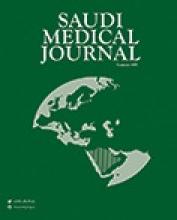Abstract
OBJECTIVE: To review all cases of valvular heart disease during pregnancy in a regional Saudi-Arabian population between 1993-1997, determine its incidence, contributing factors and its effect on the outcome of pregnancy.
METHODS: A retrospective study of 33,200 cases between 1993-1997 performed over a period of 5 years in the Department of Obstetrics and Gynecology in King Khalid University Hospital, Riyadh, Kingdom of Saudi Arabia. Most patients were Saudi nationals (83.4%). Evidence of heart disease was detected in 166 pregnant women, an incidence of 0.5%. Valvular heart disease was present, either as a single valve involvement or in combination, in 76% of the patients. The remaining 24% were a miscellaneous group including patients with cardiomyopathies, or pulmonale and septal defects. The data collected was analyzed using Gold Stat Software Package.
RESULTS: As a single valve disease, mitral valve involvement was predominant (94.5%), compared to aortic valve (5.5%). The most common condition involving mitral valve was the valve prolapse (39.2%), followed by mitral regurgitation (19.9%) and mitral stenosis (16.9%). Twenty-four percent of the pregnant women with valve disease had multiple valve involvement. Forceps were applied in 8.4% of the patients and ventouse deliveries in 1.2%. Cesarean section was performed in 3.6% of the cases, out of which 2.4% were emergency lower segment cesarean section and 1.2% were elective. No maternal or infant mortality occurred. All infants were normal and healthy with mean infant weight of 3.24 +/- 0.52 kg. Prophylactic antibiotics were administered in 83% of the patients. None of the patients, whether treated with antibiotics or not, developed infective endocarditis.
CONCLUSION: Presence of valvular heart disease in our study did not appear to affect the outcome of pregnancy, but its accurate diagnosis and management demand a greater understanding of cardiovascular physiology and its pathophysiology in pregnancy, labor and the puerperium. The successful management of the woman with valvular heart disease in pregnancy required complete cooperation between the patient herself, the obstetrician, cardiologist, anesthetist and other supporting medical staff, to optimize the outcome for both the mother and her baby.
- Copyright: © Saudi Medical Journal
This is an open-access article distributed under the terms of the Creative Commons Attribution-Noncommercial-Share Alike 3.0 Unported, which permits unrestricted use, distribution, and reproduction in any medium, provided the original work is properly cited.






